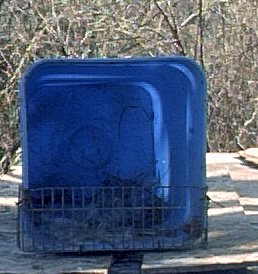

Breeding Rabbits
Breeding rabbits can be fun and exciting if it is carried out in a conscientious and responsible way. First, let's talk about the mechanics. A rabbit has an 18 day estrus cycle - this is the time that she ovulates and can be impregnated. A doe usually matures sexually a little faster than a buck. In small breeds, this is around 5-6 months of age while the larger breeds can take up to 10 months to mature. It is important not to rush your animal into breeding at a young age if you want to increase your chances at a successful conclusion! A rabbit will stay sexually active for a very long period of time -some up into 7 or 8 years of age but we generally retire ours from breeding at about 3 years of age.
To breed the doe, take the doe TO THE BUCK'S CAGE! Never take the buck to the doe's cage because does can be very territorial and harm a buck for entering its' territory. Cage breeding is accomplished by placing the doe in the buck's cage for copulation. It has been found that if you allow the buck to breed the doe 2 times within 4-5 minutes of each other or two times with one hour between the breedings, you will increase the size of your litter and also the chance of success.
A doe that is not ready to breed will "refuse service". She does this by firmly planting her bottom on the floor or running around 'growling'. If this is the case, simply remove the doe and try again every day at approximately the same time until she accepts service.
To table breed, simply place the rabbits on a grooming table or other safe, controlled location and let nature take its course. Many breeders prefer this method so that they can verify that the doe has been bred and also to insure the safety of the animal's involved.
Gestation for a rabbit is between 27-34 days with the average being around 31 days. At about 27 days, you will want to place a nestbox into the doe's cage. Your nestbox should be just large enough for the doe to turn around in but not so large that she will want to sit in it. A nestbox that is too large will encourage the doe to sit in it and also to use it like a litterbox. Pictured are some different types of nestboxes. There are open topped wood boxes, closed top wood boxes, metal boxes (removable floors which aid sanitizing), and even a plastic laundry soap bucket works well. Some people prefer to use wire boxes and lind them with cardboard while others use apple crates. The main thing to remember is that the doe must be able to get in while keeping the babies in!


Fill the nestbox with nesting material such as straw, grass hay, finely shredded paper, or even wood shavings. The doe will do the rest! At 31 days, start gently checking the nestbox. If you find kits(baby bunnies), replace the fur and nestbox and leave mom to tend to them. It is wise to gently check the nestbox each day so that any dead kits can be removed before soiling the box and creating harmful bacteria. A rabbit will only nurse twice a day and so you may not see her in with her kits but this is okay! In the wild, a rabbit will stay away from her nest to protect it from predators since they can not retrieve the babies like a dog or cat. In fact, in the wild, a burrow will be built with a downward slope so that the babies will roll back into the nest.
If you find any kits out on the wire, simply pick them up and place them back into the nestbox. In extreme weather conditions, you may remove the nestbox into a safer climate, returning it to the doe every 10 - 12 hours for nursing. They latch onto the nipple quickly and nurse rapidly so a feeding should take only about 10-20 minutes maximum.
After the birth of the babies, you will need to increase the feed to the doe to help her maintain her health while nursing the litter. At about 10 - 14 days, the kits eyes should open and within 3-4 weeks, you may remove the nestbox from the cage and allow the babies to romp freely on the cage floor with their mom. Weaning should not be done before 6-8 weeks as anything younger can stress out the kits and increase your mortality rates in your litters.
Good luck and remember - only breed the best example of a breed because two wrongs do not make a right AND remember to never breed without a plan of providing for the potential offspring - unwanted pets are everyone's problem!